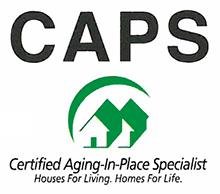Aging in Place Home Modifications Consulting for Car Crash Victim
CAPS Logo
Recently Richard Acree of ADA Inspections Nationwide, LLC, provided aging-in-place home modifications consulting services for a victim of a serious head-on collision. Richard is a Certified Aging in Place Specialist (CAPS) home modifications consultant for individuals living with disabilities.
The collision happened on an interstate highway when one driver lost control and their vehicle crossed the median, missed one oncoming vehicle, then crashed into the second oncoming vehicle head-on. The two people in the vehicle that lost control died. Miraculously, the driver of the other vehicle survived the accident but with many serious injuries.
The survivor spent months in a hospital and underwent multiple surgeries for many broken bones and internal damages. Sadly, the survivor eventually had to have a leg amputated below the knee. A prosthetic was clearly in the future for the survivor in addition to significant physical therapy for all the injuries suffered. It became obvious that when the survivor did get released from the hospital and rehabilitation, going home would require many different alterations to the home to make the home accessible. It was anticipated that the survivor would need to use a wheelchair for a period of time when they returned home, and possibly again in the future as they age.
The home is a three story structure including a full basement. A vertical home. Vertical transportation is required to reach the different levels of the home. The only vertical transportation inside the home before the crash is accomplished by stairways. Stairways are not part of an accessible route.
Many different alterations were recommended by the CAPS consultant. For vertical transportation, options included an elevator connecting the first/main floor to the basement, a platform lift in the garage connecting to the first/main floor, and stairway lifts. Elevators and platform lifts are considered part of an accessible route in any facility. Stairway lifts are not normally ADA compliant but could be effective in an aging-in-place installation.
Elsewhere in the home the following alterations were recommended:
Driveway repair for excessive slope and damaged surface.
Exterior route repairs and replacement for excessive slope, excessive abrupt change in level, and damaged surfaces.
Exterior route repair or replacement for surfaces that are not firm, stable, and slip-resistant.
Exterior decks that are usable by stairs only and guardrails and/or handrails are non-compliant.
Interior and exterior door alterations for handles that require tight grasping, pinching, and/or twisting of the wrist to operate, and for door thresholds that are too high in height relative to the adjacent floor.
Some interior door widths should be widened to at least 32 inches.
Door maneuvering space for some interior doors must be improved.
Improvements in the existing stair system connecting the first/main floor to the basement to make the tread depths at least 11 inches.
Increase the width of the routes in the kitchen to at least 36 inches.
Alter the kitchen counters so there is a work space near the sink and oven that is not more than 34 inches above the adjacent floor.
Alter the kitchen sink so the disabled individual can approach in a forward direction using a wheelchair.
Alter the height of the kitchen island counter so there is part of the surface that is not more than 34 inches above the finished floor.
The microwave oven should be relocated from above the range to a place on the counter or within the lower cabinets.
Cabinets in the laundry room must be lowered to within accessible reach ranges.
All the bathrooms must be altered to increase accessibility for entry, sinks, toilets, and showers, as applicable.
All items in the list above are pertinent to the disabled occupant and to the concept of aging-in-place home modifications. These alterations are necessary not only for the disabled occupant, but also for the care giver(s) who will be assisting the survivor of this accident. Based on the list above, a list of contractors and vendors to interview for repairs and/or alterations and an estimate of repairs or alterations should be prepared. Once the contractors and vendors are chosen, contracts should be prepared to begin the installations. Alterations should be monitored during installations and inspected for compliance with the principles of the ADA after the installations are complete and before final payments are processed.
The costs of the installations recommended above was estimated at $160,000. This information was made available to the client so they could forward to their insurance company and attorney to assist during the settlement for this case.
SUMMARY: Nobody wants to go through what this individual did as a result of this accident. But accidents happen and the needs of people can change accordingly. Aging-in-place home modifications can help mitigate the effects of such accidents. If you know someone who has been injured in an accident, don’t hesitate to contact a CAPS consultant as soon as possible. Aging-in-place alterations take time. These changes should be made quickly to help victims adapt to a lifestyle as normal as possible.
…………………………………………………………………………………………………………………………………………………………………………………………………..


